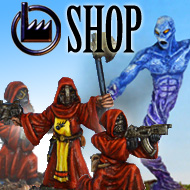|
|
These are a great example of what’s so appealing about using the Judge Dredd universe as the setting for a tabletop game. There’s just years and years of really inventive content that builds the world. In Mega City One, the bored citizens turn to one ridiculous and/or dangerous fad after another to pass the time; one of them is to put on as much weight as possible and then engage in competitive eating contests.
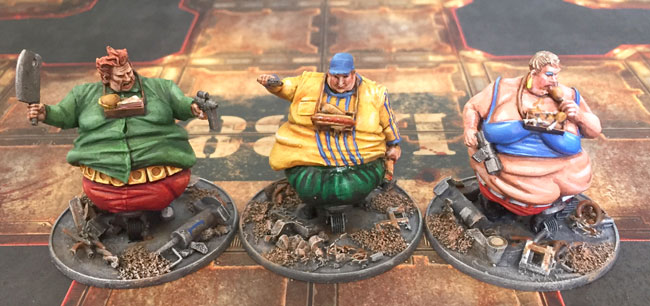
As part of my ongoing ‘Finish a model per day’ effort, these three have just rolled off the production line. They are part of Warlord’s new range and these multi-part resin models are just perfect. Full of character and detail from the little trays of food to the flab bulging over the belly wheels.
The Fatties best game move is to roll forwards on their belly wheels and deliver a crushing close combat attack – something which worked to deadly effect in one of our recent games.
How many judges does it take to stop a Block war? I don’t know but this lot could take down a lot of perps trying. Just finished them – mostly picking out details and doing the bases.
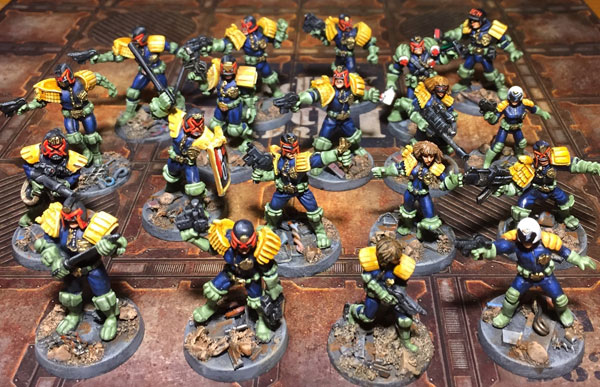 There’s a wide variety of manufacturers and types of judge here. There are 3 from the new Warlord range, one from Wargames Foundry and all the rest are Mongoose. Only the Warlord ones are still in production. For types of judge, there are cadets, a rookie, a psi judge, an exorcist, a sniper, a heavy weapon, two riot judges, a med and a tech. We’ve been playing the new Judge Dredd game from Warlord. It’s written by Andy Chambers, and uses the activation system from Bolt Action. The model count is very small – 10 models a side feels like a pretty large game, so it’s very easy to get started. Judges are typically double the points of anything else, so there’s almost no way this lot are ever going to get on the table in one go, but it still feels good to have so many to choose from. There’s a wide variety of manufacturers and types of judge here. There are 3 from the new Warlord range, one from Wargames Foundry and all the rest are Mongoose. Only the Warlord ones are still in production. For types of judge, there are cadets, a rookie, a psi judge, an exorcist, a sniper, a heavy weapon, two riot judges, a med and a tech. We’ve been playing the new Judge Dredd game from Warlord. It’s written by Andy Chambers, and uses the activation system from Bolt Action. The model count is very small – 10 models a side feels like a pretty large game, so it’s very easy to get started. Judges are typically double the points of anything else, so there’s almost no way this lot are ever going to get on the table in one go, but it still feels good to have so many to choose from.
This year I’ve challenged myself with finishing an average of one model per day in 2020. Sounds pretty ambitious, but I think it’s possible, especially with my son pitching in and helping me, and the ready supply of models that are already half done. This batch of 19 has upped the score considerably. I think I’m lagging behind a bit, but not by much.
The blog has been very neglected for some time, for a number of reasons, so I thought I’d try to start posting more once again. As it’s hard to get round to it, I thought the best thing to do was start with some really simple posts and see if I can get it rolling again, so here we go.
A few months ago, Warlord Games brought out a new Judge Dredd game, written by the legendary Andy Chambers. It’s a great system and I’ve played quite a few games since it came out. More of that later (perhaps).
It’s prompted me to start working through a load of Judge Dredd suitable models to use alongside the new official Warlord ones. On the left we have a riot judge from the Mongoose range. He’s about to gum those citizens in place with lashings of riot foam. On the right are some civilians from the Wargames Foundry Street Violence range.
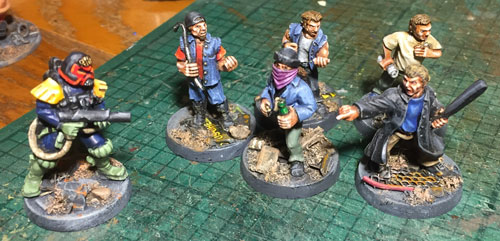
In future posts, you can expect more of Judge Dredd, preparations for BOYL 2020 and maybe even a bit of 15mm WW2 Normandy for those of a more historical leaning. If anybody’s actually reading this, do please comment and it will help motivate me to keep going.
A pair of gorgons that have finally escaped the ‘in progress’ painting tray. The one on the right is a Reaper model – at UK Games Expo they were running a ‘paint and keep’ table. I turned up right at the end of the day, and knocked this out in 15 minutes, which was challenging when almost every part of it was covered in simultaneously wet paint when I wanted to dry brush. Doing the base at home afterwards probably added another 5 or 6 minutes (I do them in batches).
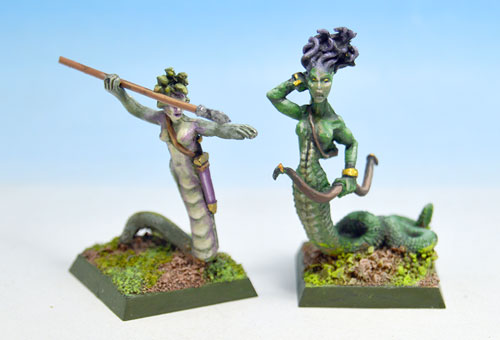
The other one is a Casting Room Miniatures model. Spent a bit more time on this one, with the purplish washes giving a bit more visual interest. Still a quick and serviceable paint job.
Gorgons are a monster in the core Ghost Archipelago book, so there’s a chance they might actually make it into a game too! As with pretty much all my fantasy stuff, they are of course on WFB 3rd edition standard size – in this case 25mm square.
We had a simple Gaslands game yesterday for the first time in a while. Our favoured format is as follows.
- Line up the cars, players take it in turns to choose one (you don’t have to work out points this way, you can just stick on any old stuff).
- Death race format
- Lots of zombies randomly placed
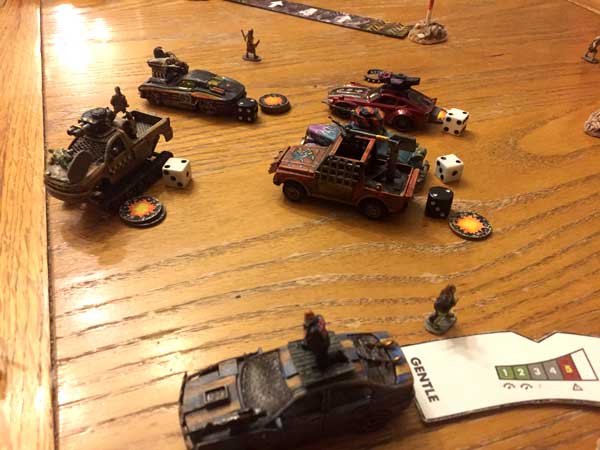 Chaos at the starting line We don’t use record sheets – car weapons are WYSIWYG. Virtually all of them are magnetised so can be easily swapped for a particular set up. The small dice are used to indicate the car’s gear and also team (black or white). The explosion tokens are the number of hazard points. They are stuck to pennies which makes them heavy enough to not get knocked around.
We each had a performance car and these ended up as the race leaders, but I managed to bungle my dice and wipe out at Gate 3. My opponent helpfully pointed me straight at the gate post, although I pulled off a great backwards turn and shifted straight up to gear 3 to stay in the race.
Here you can see the race leader struggling with a zombie who had climbed on to the bonnet and made repeated attempts to get through the windscreen and scoop out the driver’s brains.
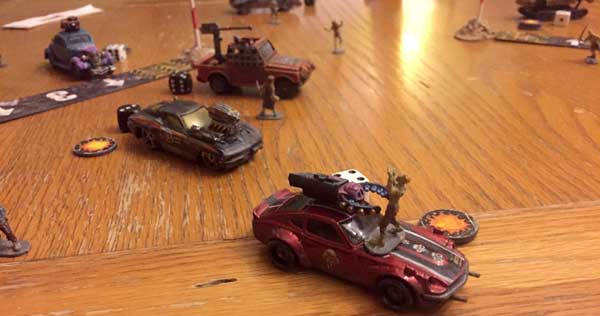
This red car powered away to win, although it was an eventful ride – it got hit by a 125mm cannon, zapped three zombies in a single turn with the arc projector and rolled one slide after another to hurtle round the last couple of gates.
Two years ago, I got what I think was the first commercial copy of Ghost Archipelago – I’d backed the Nickstarter, and just before they were sent out to the other backers, I called in at North Star and picked it up in person. Ironically, it’s now two years later and I still haven’t got round to playing a game yet (which must make me one of the last backers to actually start playing). I have, however, been amassing some stuff to play it with, and the latest are these rowing boats. Sailing on the tropical waters was one the most appealing elements in the setting for me, both in terms of gameplay and aesthetics, so I wanted to use boats in lots of the games, but I didn’t have any…
I created the original of these boats, and they have now been cast by Ramshackle Games. They are newly available here: Ramshackle website
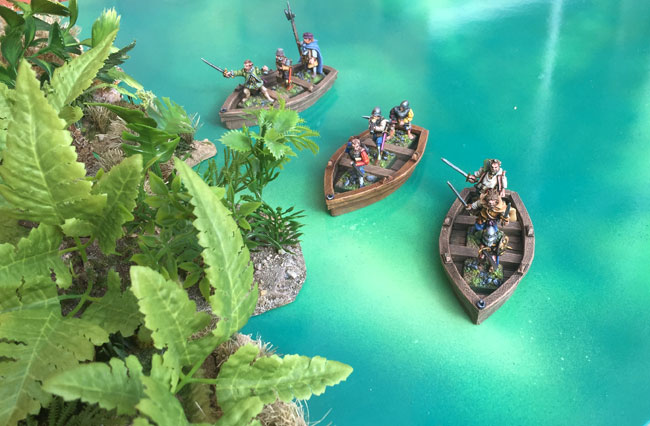 Rowing boats approach the shore
The crew are also freshly painted, I’ll post about them shortly.
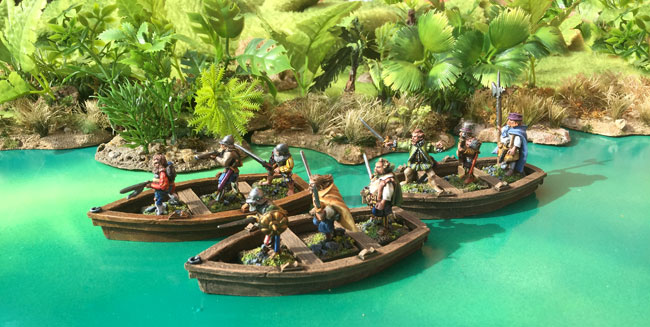 Looking for a landing point
I’ve been playing some of the Blood Red Skies campaign and to help track which pilot is which, I’ve made these name tags that fit on top of the bases. There are sets for British, German, Japanese, US, Russian and Italian. If you’d like to edit the names, the source Photoshop files can be downloaded here.
Zip file containing all 6 nations
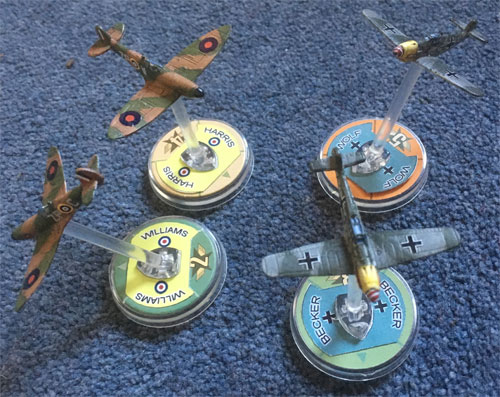
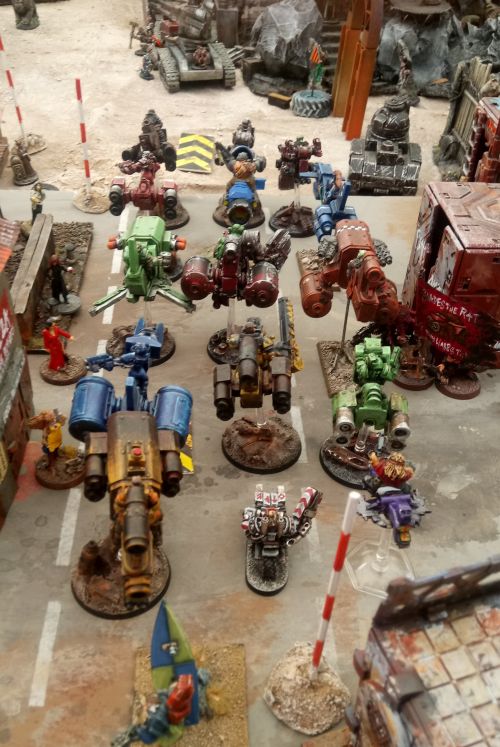 Picture from Ramshackle Games At this year’s BOYL I ran another jet bike race on the Helsreach table. We had at least 15 players, so the rules had to be very fast moving. At the beginning of each turn, all the players decide how fast they are going, typically 36″-72″ – these are fast machines. They are then moved in order, from front to back, with each player rolling to see how many hazards they can avoid. If the total move takes them past more hazards than they are allowed, they roll on each subsequent hazard to see whether they squeeze past or crash.
We had a very successful game (at least everyone seemed to enjoy it, and gameplay zoomed along appropriately). I had adjusted the rules from the previous year, and based on this year, I think it needs some further adjustments.
The first issue was that it wasn’t quite dangerous enough. Pretty much everyone finished, in spite of some seriously reckless play. The handling chart meant that many players who were putting down huge speeds were automatically getting zero hazards avoided, which meant that they rolled a d6 for each hazard:
1, 2 – No penalty
3 – Stop
4, 5 – Handling Penalty
6 – Collision
The handling penalties didn’t make much difference (because they were getting zero hazards anyway), the collision was relatively unlikely, so what typically happened is they would get a Stop at some point. In other words, instead of hurtling to a fiery death, they just went slower than they wanted to, which wasn’t really the right end result.
So, I’ve slid the whole chart along one point, and it’s now a lot nastier:
1 – No penalty
2 – Stop
3, 4 – Handling Penalty
5, 6 – Collision
I’ve also applied a Failure roll modifier at higher speeds, 72″ or above is -1, and 96″ or above is -2, further reducing the chances of a massive run resulting in anything but a battered fireball.
Finally the bandings were a bit crude, they jumped up in 12″ speed bands – it’s easy enough to expand the chart, so I’ve gone to 6″ bands in the most common range.
Some other minor tweaks to damage results:
- As one unlucky player pointed out, the ‘spin out and miss a turn’ result is actually very bad in the context of a one-off race. I’ve moved it higher up the chart, although it’s still in ‘minor’.
- Accelerator damage wasn’t bad enough. The minimum speed it inflicted didn’t make any difference because everyone was going faster than that anyway.
- The fire wasn’t bad enough – the races are so short they will probably only take a couple of minor damage, so it now starts off with two minor damage.
- Power unit needed changing for the same reason. Now explodes on a 9 or 10 on handling roll (i.e. if you roll really well you explode – cruel eh?)
- Engine malfunction was a bit boring – bike limps along at 12″. Now if you get 6+ on handling roll it does 12″, otherwise full distance. So if you roll well, you don’t go anywhere, if you roll badly, you shoot off and probably crash.
If you didn’t play in the game then the above won’t mean much to you, so the best thing to do is to have a go yourself. You just need some jet bikes, a table with obstacles on, and something to mark out the course.
Here’s a link to the Quick Play / Reference sheet which should be enough to get you going. I’ve got a more comprehensive set of rules in draft, including a wide range of add-ons for the bikes.
Reference Sheet PDF v3
Of the three main elements of most shows, demonstration games, participation games and stalls, I think that as a punter, the most important of these is the participation games. Demonstration games are pretty and inspiring, and stalls are filled with bounty but participation games are full of ideas and entertainment. Thinking back to years past, it’s the participation games that I really remember.
As the unsung heroes of shows, I thought I’d write a few up from Partizan last week – here’s the first. I think this one might have been Harrowgate Wargames club, judging by its position on the show map, but I’m not sure.
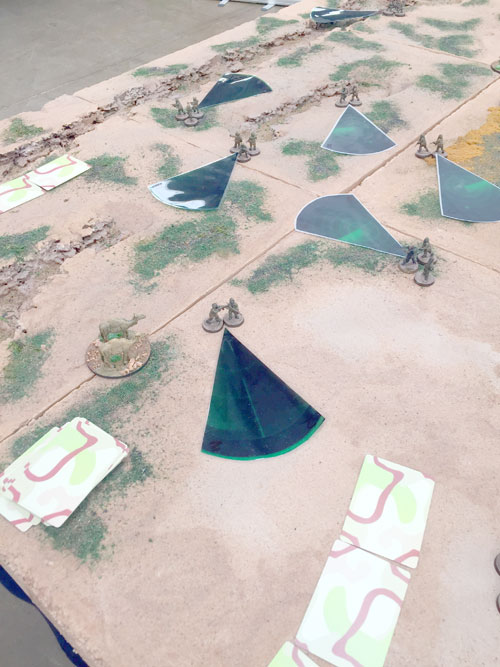
It’s set in the first Gulf War. Each player takes an SAS patrol, which has to sneak up the table and call in an air strike on a Scud launcher. The table is covered in Iraqi patrols, which need to be evaded – the arc templates indicate the zone each is observing.
The cards on the table are a set of playing cards as issued to US troops – the turn starts by each player laying down cards to indicate their path. These are then turned over one by one – the SAS move to the far end of the card. Each Iraqi patrol has a number, so for example, a ‘3’ card would activate patrol number 3, and the suit indicates whether they turn clockwise, anti-clockwise, move forward etc. A picture card allows the umpire/Iraqi player to select a patrol. The SAS player has to turn their whole set, so if a patrol heads towards their chosen path, they have no option to change course – all they can do is cross their fingers and see what happens – a great tense game mechanic.
If the SAS stray into the arc of a patrol, then they play a game of “High/Low”. A certain number of cards are laid out (depending on whether the patrol is in cover), and as each is turned over, the SAS player has to guess whether the next will be higher or lower – if they are wrong, they are spotted. This is another tension builder that echoes the process of creeping along.
There’s not a huge amount of decision making, but it was a good looking table, a quick-to-play game and the game mechanic was both engaging and evocative of the scenario. Great stuff!
These were put together as part of some scenic items I put together for a friend’s 6mm collection. Field tiles will be following, but when I was getting these trees together I figured they are a bit too small scale for 6, but would be fine for 2-3 mm, of which a couple of the group are putting together a separate project. Although these are probably too small for 6mm, I think that the same principles could easily be applied to produce something that would fit. Bigger foliage clumps and a larger mesh grid would do the trick.
The basis behind this is that I wanted something that looked like a wood and would enable figures to be positioned under them if absolutely necessary, but which would also allow bases to be sat on top without destroying them. Also, for flexibility, if it had to straddle a low wall or hedge on the table it could do that without having to provide exact gaps or be fixed to the field tiles.
Started with some wire mesh. It is a galvanised mesh in 6-7mm squares. It will be self-supporting by bending wires to 90 degrees around the edge. Some of the larger pieces will have internal glades which can be seen in 2 of the mesh pieces in the first picture. The second picture shows where the cut ends have been bent in this way.
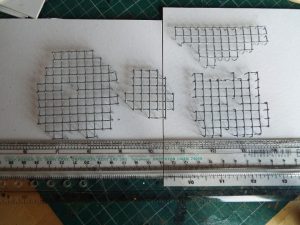 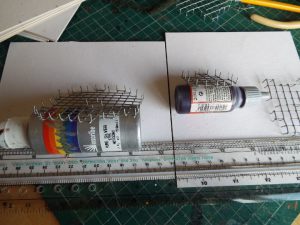
Before having anything attached to the mesh pieces they are sprayed Army Painter Brown – Leather I think. The idea is that these are the trunks of the trees showing around the edge. When that is dry the mesh items have a thin sheet of scourer glued to the top. These are simply cheap scourers which are carefully split into 2 or 3 horizontal sheets – a little bit time consuming but not too bad. Using the whole scourer means the layer is a bit too thick at this scale. The scourers have 3 purposes – they soften the shape of the grid, overhang the tree trunks at the edge, and provide a better key when gluing the tree foliage on top. When dry cut the scourer to leave a 2-3mm overhang around the outside edge, or around the internal glades.
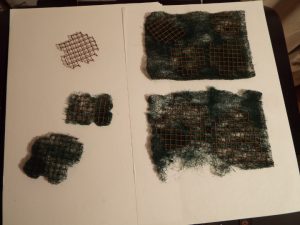
Using PVA or Gorilla glue, attach clumps of the chosen tree foliage to the upper surface of the scourers. This shows Woodland Scenics Medium Green clump foliage in place.
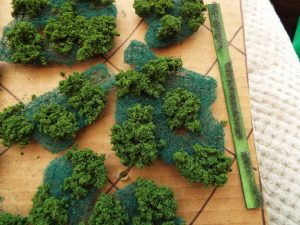
I then used Light Green. Unfortunately I didn’t have any other shades of clump foliage to hand. However, the scourer means that smaller pieces can be glued in without falling through the wire mesh. It won’t give you height, unless you allow a layer of the finer stuff to dry and then repeat using additional layers to build it up gradually.
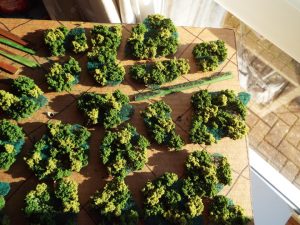
Plan B was to shred some cheap sponge and colour it with acrylic paint. A bit lurid in places. I did the shredding by hand – if I wanted a larger batch I would have used a blender or a coffee/spice grinder. I decided to have some of the darker pieces in a conifer shape to break up the tree line. First step was to cut a cone shape, and then I then carefully tugged out tiny bits of foam using a pair of wire clippers to create the layers of foliage on the tree, then gluing it into a suitable gap. This is time-consuming, but I think the effect is worth it.
The hedging strip in the first picture below is 6″ long and included to show scale, and the Lego brick is included in the second picture for the same purpose. Not including the lugs on top of the brick, it is just shy of 1cm high.
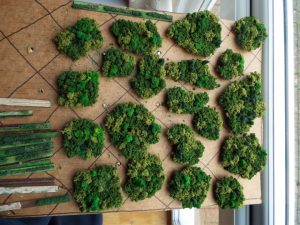 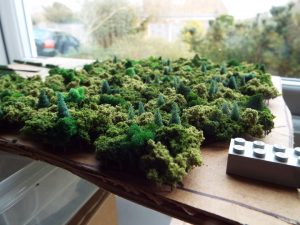 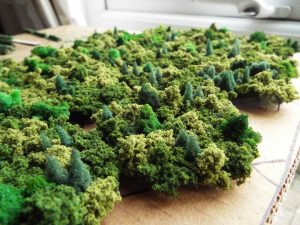
I would recommend a spray of watered down pva to help fix the foliage, although I’ve been too lazy to follow my own advice on these.
Hope you find this tutorial of use. It would be good to see other’s attempts at this sort of scale.
Al
|
|




















